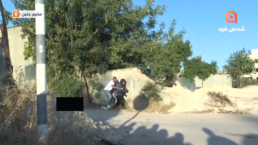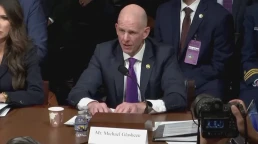By Robin Andersen, FAIR.org
On May 13, two days after the killing of Al Jazeera journalist Shireen Abu Akleh by Israeli Occupation Forces, as her loss still dominated international news cycles, thousands of Palestinian mourners gathered to pay tribute to the woman who had given them voice for so long. They came to lay her body to rest.

Immediately, as the funeral procession was just starting, images emerged of Israeli forces attacking the pallbearers as they attempted to carry her coffin across the courtyard from the French hospital in East Jerusalem. One of the first reports came from British-Egyptian correspondent Emir Nader with BBC News investigations, who posted footage and said on Twitter (5/13/22): “Horrible scenes as Israeli security forces beat the funeral procession for slain journalist Shireen Abu Akleh and the crowd momentarily lose control of her casket.”
Al Jazeera carried the funeral live on air, and the footage showing the attack was widely shared over social media. One Twitter user (5/13/22) described the video, referring to the IOF, or Israeli Occupation Force:
Everyone switch on to Al Jazeera right now. This is one of the most horrifying things I’ve seen. IOF is attacking mourners carrying Shireen’s body from the hospital right now. They’re using stun grenades and tear gas and charging at them with horses and batons.
The Intercept (5/13/22) noted the footage that unfolded on live television, stunned viewers and only “intensified the outrage over her death.” Video was quickly remixed and shared, and the article linked a 45-second video on Twitter (5/13/22) posted by Rushdi Abualouf, a Palestinian journalist working for the BBC. Described as “the closest video” of the attack, it mixed Arab instrumental music over a slowed version that show helmeted, uniformed riot police singling out pallbearers and smashing bare arms with batons as mourners struggled to keep the casket upright.
The language of obfuscation
Mirroring the euphemism-dominated coverage of Abu Akleh’s killing (FAIR.org, 5/20/22), many of the first corporate press reports employed language that mystified what was happening at the funeral.
MintPressNews editor Alan MacLeod recognized the language of obfuscation, posting a series of news headlines on Twitter (5/13/22) that transformed black-clad Israeli riot squads wantonly beating pallbearers into “clashes.” Referring to an article he wrote for FAIR (12/13/19), MacLeod (5/14/22) observed that the word “clash” is used by media “when they have to report on violence, but desperately want to obscure who the perpetrators are.”
Violence comes from nowhere, it simply erupts: CBS‘s headline (5/13/22) was, “Shireen Abu Akleh Funeral Sees Clashes Between Israeli Forces and Palestinian,” updated later that day to report that “Violence Erupts” at the funeral as Israeli forces “Confront” mourners. The Times of Israel (5/13/22) had “Violence Erupts as Journalist’s Casket Emerges From Jerusalem Hospital.” And the BBC (5/13/22) went with “Shireen Abu Akleh: Violence at Al Jazeera Reporter’s Funeral in Jerusalem.”
CBS‘s language prompted one Twitter user (5/13/22) to wonder about
the best term for lies by omission, untruths couched in deliberately obfuscating language. Perhaps “willfully misleading”? Denial of facts, even gaslighting, given the footage circulating of attacks on pallbearers….
An exception was a report from Jerusalem by Atika Shubert for CNN (5/13/22) headlined, “Video Shows Israeli Police Beating Mourners at Palestinian-American Journalist’s Funeral Procession.” It opened:
Israeli police used batons to beat mourners carrying the coffin of Al Jazeera journalist Shireen Abu Akleh…. Tear gas was fired by Israeli forces and at least one flash bomb was used.
Mondoweiss (5/13/22) pointed out that the “White House says it ‘regrets the intrusion’ into Shireen Abu Akleh’s funeral, but it doesn’t condemn Israeli police actions.”
Repression as retaliatory
Reporting went from bad to worse when the Israeli government issued an official statement claiming that police had to respond to Palestinian violence. Many Western news outlets repeated the claims.
Under an early BBC video (5/13/22), after “clashes broke out” and “violence erupted,” the text read, “Projectiles are seen flying towards the police, who also fired tear gas,” and then, “Israeli police said officers at the scene were pelted with stones and ‘were forced to use riot dispersal means.’”
In a later, longer version, the BBC text (5/13/22) opened with, “Police said they acted after being pelted with stones,” and repeated, “Police said officers ‘were forced to use riot dispersal means.’” The body of the text included on-the-ground reporting that accurately described what happened, only to be followed with more back-and-forth accusations.
The descriptive reporting on the funeral attack and Israeli brutality, followed with patched, confused “balance” between Palestinian and Israeli statements–contention often going back decades–began to characterize coverage. This style of journalism presents repression surrounded in a fog of inevitability, rendering even eyewitness accounts inexplicable, without context or solution.
As many reports repeated Israeli justifications for the attacks, presenting Israeli state repression as retaliatory, the Intercept (5/13/22) refuted the official Israeli version, showing how it fabricated Palestinian violence.
On Twitter (5/13/22), activist Rafael Shimunov explained how the Israeli police account used drone video to “prove” that two of the mourners had thrown rocks at police:
But a comparison of that video to ground-level news footage showed that the police video had been edited to remove the initial police charge and slowed down to make it seem as if a man who just waved his arms in frustration had thrown something at the officers.
Shimunov concluded that the mourner had no stone, his “action was putting his body between them and Shireen Abu Akleh’s casket.” He added: “To be clear, no stone justifies attacking mourners at a funeral of a journalist assassinated by your military.”
‘This isn’t a tussle’
All the media techniques come together on a CBS video posted on Twitter (5/13/22), with overlaid text saying police “clashed” with mourners, and that the “tussling” was so bad they almost dropped the coffin. “Projectiles could be seen flying through the air as Palestinians chanted anti-Israeli slogans,” the network declared.
The response on Twitter was outrage. One user (5/13/22) replied:
This isn’t a tussle or push back. This is an occupying force abusing its power. The sooner @CBSNews calls it how it is, the sooner we can pressure change. Do better.
Another “fixed” the headline, changing “clashes” to “attacking,” and switching Abu Akleh being “killed” to “assassinated.” Another Twitter used said, “These are violent occupiers (who killed journalists prior #ShireenAbuAkleh) invading a funeral… not a ‘tussle.’” Yet another asked:
Oh clashing was it? Clashing? Very interesting choice of words for being attacked by armored thugs during a peaceful memorial for a journalist those armored thugs also murdered.
Another tweeter was “imagining the headline ‘Ukrainians left dead in Bucha after clashes with Russian forces.’”
Posting an unedited video in response to CBS, a user asked: “Why was this clip cut?… to falsify the facts of course.”
In fact, the actual footage was stunning for its clear view of one-sided violence—beginning unmistakably when helmeted Israeli forces stormed the crowd and began to beat pallbearers with batons. The pallbearers stumble and are sometimes ripped from their positions, but they never retaliate. One tries to shield his head with his arm. A man wearing jeans, tennis shoes and a sleeveless shirt kicks at the helmeted, uniformed police, trying to stop them from hitting the pallbearers. Those carrying the coffin do all they can to prevent it from falling, ignoring the blows.
Al Jazeera (5/12/22) interviewed Marc Owen Jones, an assistant professor of Middle East Studies at Hamad Bin Khalifa University, who said that Israel has a track record of creating ambiguity over social media as a strategy to “muddy the waters,” knowing that many press accounts will repeat their claims.
‘Incitement’ or expression?
Explaining the funeral attacks, the Intercept (5/13/22) reported, Israeli police “said they attacked the procession because mourners waved Palestinian flags and chanted nationalist slogans.”
NPR (5/13/22) also reported, “Police said the crowd at the hospital was chanting ‘nationalist incitement,’ ignored calls to stop and threw stones at police.” It added, citing police, that “the policemen were forced to act.” NPR went on to explain why police raided Shireen’s family home, saying they “went” there “the day she was killed and have shown up at other mourning events in the city to remove Palestinian flags.”
The CBS video (5/13/22) posted on Twitter overlaid with text also read, “Al Jazeera said Israel had warned her brother to limit the size of the funeral and told him no Palestinian flags should be displayed and no slogans chanted.” They followed with, “The network said he neglected to take that guidance given the outpouring of grief and anger over the reporter’s killing.”
No comment is made about Israeli repression of Palestinian freedom of expression. “Neglected” and “guidance” are unlikely choices of words from Al Jazeera, given that the network published a scathing piece (5/12/22) slamming Western media coverage for obscuring and denying Israel’s murder of its journalist, calling it a “whitewash.” Al Jazeera has assigned a legal team to refer the killing of Shireen Abu Akleh by Israeli forces to the International Criminal Court (Al Jazeera, 5/27/22).
Though CNN journalist Atika Shubert (5/13/22), reporting from the funeral, acknowledged Israeli attacks, she ended by saying that the family was “told not to display the Palestinian flag, that was a special request, but as you can imagine, it’s very difficult to control these crowds,” and the flags were flying. The “request” was a raid on Abu Akleh’s family home, where flags were forcibly removed. Restrictions on flying the Palestinian flag are normalized within these stories, not exposed as violations of human rights and freedom of expression.
When US media routinely repeat without comment Israeli “reasons” for “clamping down” on any display of support for Palestinian statehood, or that Palestinians were “chanting nationalistic slogans,” amounting to “incitement,” they condone the repression of Palestinian rights, which would cause other countries to be called dictatorships, or at least authoritarian regimes. Yet Israel is still listed as a democracy. As Nolan Higdon (5/28/22) pointed out, “You Can Kill and Censor Journalists or You Can have Democracy—You Can’t Have Both!” Such attitudes toward Israeli repression of Palestinian expression are a major contradiction by US media institutions, which themselves enjoy press freedoms and should be able to recognize when those freedoms are being violated.
Rashid Khalidi, Palestinian American and Columbia University professor, told FAIR that US media are “terrified of being attacked if they don’t repeat the Israeli versions of events. They live in constant fear. This happens on the ground, and during editing.” These practices were confirmed in an article published in Slate (5/22/21) last year, when a journalist admitted having trouble “reporting the truth” from Gaza.
‘System of domination’
There are rules for occupying forces articulated by the International Committee of the Red Cross on Occupation and International Humanitarian Law (4/8/04); these prohibit the collective punishment of occupied peoples. Violent repression of nationalist slogans and the Palestinian flag violates the International Declaration of Human Rights, rights which are established for those living under occupation.
Writing for Common Dreams (5/23/22), the Institute for Policy Studies’ Phyllis Bennis and Princeton’s Richard Falk noted that Israeli forces “threw Palestinian flags to the ground and violently beat mourners—including the pallbearers.” They placed the attacks into a context of “the structural nature of Israeli violence against Palestinians,” citing an Amnesty International report on Israeli violence in the Occupied Territories characterizing it as a “Cruel System of Domination and Crime Against Humanity.”
The killing of Shireen Abu Akleh and the supposedly defensive attacks on mourners are part of a “pattern of repression…far more pervasive,” and in fact codified in the country’s Law of 2018, which grants only Jewish citizens the right of self-determination. Along with Amnesty, Human Rights Watch and B’tselem, Bennis and Falk concluded that this “constitutes the crime of apartheid.”
This point was made visually online by Tony Karon (Twitter, 5/13/22) , a lead editorial writer at Al Jazeera, who set pictures of South African apartheid next to Israeli attacks on the funeral with the text:
African police in ‘87 attacking the coffin of Ashley Kriel to seize the ANC flag that draped it: Israeli police attacked the coffin of #ShireenAbuAkleh today, trying to seize Palestinian flags. Apartheid regimes waging war on their victims, even after death.
US responsibility
For decades, the United States has unconditionally provided Israel with “political, diplomatic, economic and military support,” Bennis and Falk wrote. Military subsidies alone amount to about $3.8 billion every year, “most of it used to purchase US-made weapons systems, ammunition and more. This makes the US complicit in Israel’s criminal wrongdoing.”
With 20% of Israeli’s military budget supplied by the US, “the bullet or the gun used to kill Shireen could have even been purchased from US weapons manufacturers with our own money.” The use of US military aid for repression is a violation of US law:
The Leahy Law’s restriction on military aid is unequivocal: “No assistance shall be furnished,” it says, “to any unit of the security forces of a foreign country if the Secretary of State has credible information that such unit has committed a gross violation of human rights.”
To date, there have been six investigations into the killing of Abu Akleh, all that find conclusive evidence that the journalist was killed by Israeli Forces. “A reconstruction by the Associated Press lends support to assertions” from both the Palestinian Authority and Abu Akleh’s colleagues, the news service (5/24/22) reported, “that the bullet that cut her down came from an Israeli gun.” CNN (5/26/22) explained, “There were no armed clashes in the vicinity,” and the text over a map reads, “Footage from the scene showed a direct line of sight towards the Israeli convoy.”
Demanding the fatal bullet
Much has been made of the bullet that killed Abu Akleh, and the Israeli demands that it must be turned over to them (New York Times, 5/12/22). This offers a last talking point for Israeli’s claim that Palestinian fighters are responsible for shooting her.
For example, when Reuters (5/26/22) reported on the investigations into her killing, it added Israeli Defense Minister Benny Gantz’s response on Twitter (5/26/22): “Any claim that the IDF intentionally harms journalists or uninvolved civilians is a blatant lie.” Reuters also included his demand that the Palestinian Authority hand over the bullet for ballistic tests to see if it matched an Israeli military gun.
Palestinian tests, noted by Reuters (5/27/22), have determined that the bullet that killed Abu Akleh “was a 5.56 mm round fired from a Ruger Mini-14 semiautomatic rifle, which is used by the Israeli military.” But Reuters followed that with the Defense minister’s claim that the “same 5.56 caliber can also be fired from M-16 rifles that are carried by many Palestinian militants,” adding: “Al-Khatib did not say how he was sure it had come from an Israeli rifle.”
As Khalidi pointed out, “Anything the Israelis say, even about an investigation, will be repeated, you will still get the Israeli version—that in the name of balance.”
The Committee to Protect Journalists (5/26/22) cited the numerous reports, including the findings of the Dutch-based Bellingcat Investigative Team, confirming Israeli culpability, and joined 33 other press freedom and human rights groups calling for an independent investigation into Abu Akleh’s killing.
‘The world knows very little’
Yet on June 3, 2022, the New York Times’ editorial board wrote, “The world still knows very little about who is responsible for her death.” The wordy piece repeated every Israeli talking point, including the justification of the funeral attack, saying Israeli police “appeared to want to prevent” the funeral from becoming a “nationalist rally,” and said the officers had acted against a mob “in violation of a previously approved plan.” In other words, pallbearers and mourners were attacked for expressing political opinions and allowing Palestinian society to participate in the burial of Abu Akleh.
The Middle East Eye (6/8/22) reported that when Abby Martin, host of the Empire Files, confronted Secretary of State Anthony Blinken at the Summit of the Americas in Los Angeles, she asked why there has been “absolutely no repercussions” for Israel over Abu Akleh’s killing. Blinken responded that the facts had “not been established” in the killing of the veteran Al Jazeera journalist, yet no independent investigation has been started.
Washington Post reporters (6/12/22) reviewed the audio, video, social media and witness testimony of Abu Akleh’s killing, and confirmed that an Israeli soldier likely shot and killed her. Mondoweiss (6/12/22) reported the findings, expressing hope that the report would “add pressure on Secretary of State Antony Blinken to actually demand an independent investigation and accountability.”
Yet even though the Post’s editorial board (6/13/22) referred its its own reporter’s investigation as “impressive,” it still called on the Palestinian Authority to agree to a joint investigation with Israel, with US participation. In what amounts to an attempt to control the narrative about Abu Akleh’s killing, the Post editorial cited “emotional” reasons for refusing to back calls for an international investigation, saying, “We’re skeptical such an impartial inquiry is possible given the high emotions, and low trust, that permeate global discussion of the Middle East.”
On June 14, 2022, journalist Dalia Hatuqa, who covers Israeli/Palestinian affairs, told Slate’s Mary Harris (6/14/22) that Blinken had promised Shireen’s famliy that there would be a full investigation, then she continued: “But honestly, nothing’s happened. It’s been a month. It’s not that hard: There’s footage, eyewitnesses, all kinds of stuff. This isn’t a mystery.”
Recent Posts
‘Total Amateur Hour’: FBI Official Says Antifa Is #1 Threat in US—But Can’t Say Where, Who, or What It Is
December 13, 2025
Take Action Now “Just a complete admission here that the entire ‘antifa’ threat narrative is totally manufactured by this administration,” said one…
Utah Leaders Are Hindering Efforts To Develop Solar Despite A Goal To Double The State’s Energy Supply
December 12, 2025
Take Action Now Utah Governor Spencer Cox signed bills that will make it more difficult and expensive to develop and produce solar energy, ending tax…
Report of the Independent Democratic Task Force on U.S. Policy Toward Israel
December 12, 2025
Take Action Now For release in connection with the winter meeting of the Democratic National Committee convening on December 11, 2025 in Los Angeles……
U.S. Realizes It Can Seize Boats After All
December 11, 2025
Take Action Now After months of extrajudicial killings in the waters off Venezuela, the Trump administration opted instead to capture an oil tanker.……




